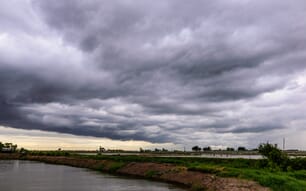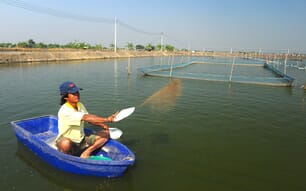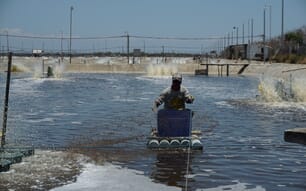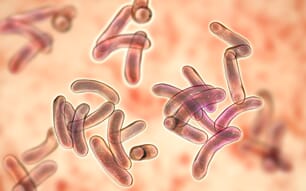Why accurate biomass estimates matter
“How many chickens do I have?” What may seem an easy question for a chicken farmer is a puzzling question for a shrimp farmer. In livestock farming, farmers have a direct visual, 3D interaction with all of their animals. With this easy visibility, they can acquire crucial data – weight, survival rate, health and stress levels of the population – at low or no cost. For shrimp farmers, this is not the case. Shrimp live on the bottom of ponds, out of sight and beyond easy reach.
Farming efficiency requires information and today the most important, unsolved data point in shrimp farming is biomass. Biomass data is crucial for calculating the average daily growth (ADG), feed conversion ratio (FCR) and probiotic regime. Biomass data also plays a critical role in farm management decisions, such as harvest time and disease identification. Currently shrimp farmers rely on manual sampling methods for estimating biomass. However, these have low accuracy and induce stress in the shrimp, as well as being labour intensive.
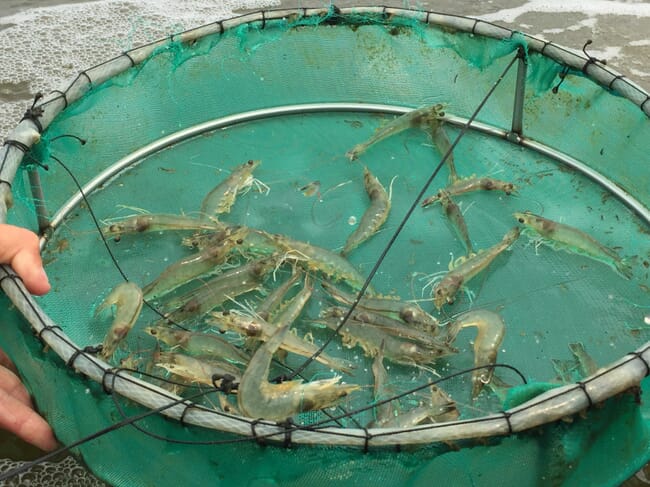
© Kurt Servin
To address this, *Alune’s farming team have designed four biomass estimation operating procedures. The farming team are also testing their own novel, low-tech invention which costs less than $15 USD. Many more technologies are emerging which we will discuss here.
What is biomass?
Shrimp biomass is the number of shrimp alive (Survival Rate/SR) times the weight of the shrimp (Mean Body Weight/MBW). Shrimp biomass is different from total pond biomass, which includes all microorganisms within the pond. Understanding the number of shrimp alive in a pond is the most complex part of calculating biomass, as shrimp distribution is unequal and depends on feeding and pond conditions.
With accurate biomass information farmers are better able to adjust feed regimes to maximise growth and minimise costs, with positive environmental and shrimp health impacts. At times of stress, such as during a disease outbreak, ammonia build-up or harvesting, understanding mortality rates and growth is vital to making feed and harvesting decisions.
The cost of inaccurate biomass estimation is high. Although no shrimp-specific data is available, a ±5 percent error on biomass estimation has caused a loss of €91 million every year for the European fish farming industry. Assuming a similar ±5 percent inaccuracy in biomass (which is optimistic), $500 million USD is being lost by shrimp farmers every year, or 65,000 tonnes of protein wasted. The real impact is likely higher than this.
In 2019, the market for precision aquaculture is estimated to be valued at $398 million and projected to reach $764 million by 2024. Aquaculture must shift to a more knowledge-based approach to achieve this, and the problem of biomass estimation is at the core of this shift. Various studies and technology companies are racing to crack the billion-dollar question.
.jpg?width=650&height=0)
© Gurvinder Singh
Biomass estimation today
Despite the importance of biomass, farmers have a limited toolkit to obtain biomass data, with growth measured from a sample of the population and survival rate measured using cast nets and/or feed trays. This manual approach relies on broad population distribution assumptions and is highly labour intensive. However, it remains the industry standard for biomass estimation today.
Stocking biomass
Establishing the number of post-larvae (PL) stocked sets the benchmark for the cycle, on to which all adjustments are made. It is common for hatcheries to provide up to 30 percent more PL than needed to account for mortality during transport and to boost perceived performance. PL counting is usually done by hand, counting a selection of the PL in their bags to estimate the average number per bag. Algebae and XpertSea
offer two non-manual solutions to completing this step. Weighing and measuring variation of PL is also important to establish health and initial stocking biomass.
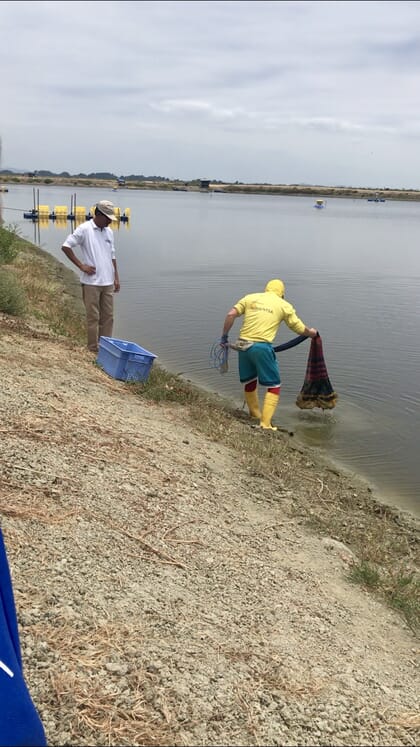
© Tarah Mayes
Nursery
When using a nursery phase pond, the transfer to grow-out is an opportunity to accurately estimate biomass in a way unachievable in grow-out ponds. The method suggested here is one of a few options, but is a stressful event for the shrimp. However, the benefits of accurate biomass and better feed conversions outweigh the risks when managed properly.
During transfer, ensure all water bodies have active oxygenation and measure at dissolved oxygen (DO) of 5 or higher, ideally above 6. Using a container, bucket or net, transfer shrimp between water bodies. Record the weight of each container of shrimp should and occasionally count the individuals in one container (along with its weight). Use these data points to calculate the total shrimp biomass. Observe the shrimps’ behaviour after transfer and estimate a percentage of mortality due to stress.
Grow-out
Identifying and estimating early mortality is important during the blind feeding phase, when disease and stress could cause significant losses without obvious signs. Whilst mortality may be hard to observe, counting dead shrimp, as well as siphoning and observing water samples for excess feeding, are tools that may be used to support assumptions. In later days of culture (DOC) cast nets and feed trays can be used to assume survival rates and pond population, although the accuracy of these methods is limited.
Measuring biomass is easier to achieve by weighing the wet or dry weight of multiple samples of shrimp from the pond. Ideally, the shrimp should be sampled from multiple areas in the same pond. This can be considered an accurate, low cost method to measure average body weight of shrimp, however it is labour intensive and stressful for the shrimp.
Partial harvests and final harvests are chances to evaluate the accuracy of your predictions and analysis during the cycle.

© XpertSea
How emerging technologies can deliver more accurate biomass data
Researchers have been trialling ways to accurately estimate biomass, hoping to find a method that’s non-intrusive and cost effective. Identifying the most representative sampling method and making estimation technologies more efficient have been the two main strategies. As it stands now, no technology has been able to address these needs, but there have been great steps forward and as shrimp farms modernise and higher cost solutions become viable.
Machine vision
Machine vision is a technology that uses a combination of big data, machine learning and cameras or sensors to acquire, process and analyse underwater snapshots of shrimp. This method has been used for rainbow trout, salmon, bluefin tuna and shrimp. Canadian aquaculture company XpertSea have developed a machine vision artificial intelligence system to measure the number, size and weight of a shrimp sample using their XpertCount bucket. XpertSea have recently launched a mobile version of their technology, which allows size and variation estimates through a mobile phone, reducing barriers for adoption of this useful solution.
*Algaeba, like XpertSea, uses machine vision for PL counting, with much faster speed and better accuracy than the meticulous hand counting method employed by many farmers. The Thai aquaculture technology company promises a 1-minute preparation and counting time with >95 percent accuracy.

Acoustics
Other ways of acquiring biomass data include using an acoustic-based method. Instead of using optics and cameras this method uses sound to capture data, using sonar cameras or echosounders. *Minnowtech, a US-based aquaculture technology company, is combining networked underwater sonar cameras and artificial intelligence to acquire biomass data directly in the ponds, at a level which represents both individual shrimp size and total pond biomass. While the technology is not yet available for farmers, it is an exciting development and innovation that promises to help shift shrimp farming towards a precision industry.

Historically the adoption of technology in shrimp farming has been slow – limited by cost and access to capital. In some cases, new technologies haven’t been embraced because farmers don’t know how to use the equipment correctly or because the benefits of the technology aren’t obvious. Manual methods have a proven track record, while new technologies require support and an integrated approach to complement how the farm team prefers to work. It is important for farmers to test and embrace innovations, while technology companies should seek to reduce barriers to adoption.
The future of biomass estimation
As the race for a farmer-friendly biomass solution continues, producers can work to improve traditional estimation methods. Accurately recording farm data, taking frequent samples, using representative sample sizes and maintaining the same procedures throughout production will make farmers more confident about the changes they observe in shrimp ponds.
Technology to simplify and assist traditional estimation methods is already here and is becoming more widely available to farmers. It is unlikely one solution will answer the question of biomass estimation, but if farmers work with technology companies, they can start seeing the bottom of the pond more clearly.
The Alune farming experts will be sharing their experiences and research in regular articles on The Fish Site as part of the Closer to shrimp aquaculture series.
*Alune, Minnowtech and Algaeba are all part of Hatch’s portfolio, while XpertSea shares an investor – Aqua-Spark – with Hatch, but The Fish Site remains editorially independent.

